What Is The Square Root Of 119
News Co
Apr 08, 2025 · 5 min read

Table of Contents
What is the Square Root of 119? A Deep Dive into Irrational Numbers and Approximation Methods
The question, "What is the square root of 119?" seems simple enough. However, delving into this seemingly straightforward mathematical problem reveals a fascinating journey into the world of irrational numbers and the various methods used to approximate their values. This article will not only answer the question directly but also explore the underlying mathematical concepts and practical techniques for finding the square root of 119 and other similar numbers.
Understanding Square Roots and Irrational Numbers
Before we tackle the square root of 119 specifically, let's establish a fundamental understanding of square roots and irrational numbers.
What is a square root? The square root of a number is a value that, when multiplied by itself (squared), equals the original number. For example, the square root of 9 is 3 because 3 x 3 = 9. This is often written as √9 = 3.
What are irrational numbers? Irrational numbers are real numbers that cannot be expressed as a simple fraction (a ratio of two integers). Their decimal representations are non-terminating and non-repeating, meaning they go on forever without ever settling into a repeating pattern. Famous examples include π (pi) and e (Euler's number).
Why is the square root of 119 irrational? 119 is not a perfect square (a number that is the square of an integer). Therefore, its square root is an irrational number. We cannot express it as a simple fraction, and its decimal representation will be infinite and non-repeating.
Calculating the Square Root of 119: Methods and Approximations
Since we cannot find an exact value for the square root of 119, we must rely on approximation methods. Several techniques exist, each with varying levels of accuracy and complexity.
1. Using a Calculator
The simplest method is to use a calculator. Most scientific calculators have a square root function (√). Simply input 119 and press the square root button. The calculator will provide an approximation, typically to several decimal places. For example, a calculator will give you a value close to 10.9087.
2. The Babylonian Method (or Heron's Method)
This iterative method provides a progressively more accurate approximation with each iteration. It's based on an ancient algorithm and works surprisingly well. Here's how it works:
-
Start with an initial guess: Let's guess 10. This is reasonably close to the actual square root.
-
Improve the guess: Divide 119 by the guess (119 / 10 = 11.9).
-
Average the guess and the result: Average the initial guess and the result from step 2: (10 + 11.9) / 2 = 10.95
-
Repeat: Use 10.95 as the new guess and repeat steps 2 and 3. Each iteration will bring the approximation closer to the true value.
Let's perform a few iterations:
- Iteration 1: Guess = 10, Result = 11.9, Average = 10.95
- Iteration 2: Guess = 10.95, Result ≈ 10.86, Average ≈ 10.905
- Iteration 3: Guess = 10.905, Result ≈ 10.9088, Average ≈ 10.9069
As you can see, the value converges quickly to the actual square root. With just a few iterations, we obtain a highly accurate approximation.
3. Using the Binomial Theorem
The binomial theorem can be applied to approximate square roots. This method involves expanding the expression (1 + x)^n using the binomial series, where x is a small value and n is a fractional exponent. This is a more advanced technique, requiring a solid understanding of calculus and series expansions.
4. Newton-Raphson Method
This numerical method is another iterative approach used to find successively better approximations of the roots of a function. Applied to finding square roots, it's quite efficient. It involves finding the root of the function f(x) = x² - 119 using the iterative formula: x_(n+1) = x_n - f(x_n) / f'(x_n), where f'(x) is the derivative of f(x). This method requires a good initial guess and involves calculus but provides rapid convergence.
Practical Applications and Relevance
Understanding how to approximate square roots, particularly irrational numbers like the square root of 119, has practical applications in various fields:
-
Engineering and Physics: Many calculations in engineering and physics involve irrational numbers. Accurate approximations are essential for precise results in designing structures, calculating trajectories, and more.
-
Computer Graphics and Game Development: Rendering realistic images and simulations often requires precise calculations involving square roots, especially in handling geometry, lighting, and physics engines.
-
Mathematics and Statistics: Approximations of irrational numbers are crucial in solving equations, performing statistical analyses, and working with various mathematical models.
-
Financial Modeling: Financial models often involve complex calculations requiring accurate approximations of irrational numbers for predicting returns, assessing risk, and other financial analyses.
Conclusion: Embracing the Irrational
The square root of 119, approximately 10.9087, is an irrational number, highlighting the richness and complexity of the number system. While we cannot find an exact value, various approximation methods allow us to calculate its value to a degree of accuracy sufficient for most practical applications. The exploration of these methods, from simple calculator usage to more sophisticated iterative techniques, demonstrates the power and elegance of mathematical tools in solving real-world problems. Understanding irrational numbers and their approximations is fundamental to numerous fields, showcasing the importance of this seemingly simple mathematical concept. The journey to finding an approximation for the square root of 119 is not just about the answer; it's about understanding the underlying mathematical principles and the practical applications that make this topic so relevant and intriguing.
Latest Posts
Related Post
Thank you for visiting our website which covers about What Is The Square Root Of 119 . We hope the information provided has been useful to you. Feel free to contact us if you have any questions or need further assistance. See you next time and don't miss to bookmark.